child restraint AUDI Q7 2012 Owner´s Manual
[x] Cancel search | Manufacturer: AUDI, Model Year: 2012, Model line: Q7, Model: AUDI Q7 2012Pages: 342, PDF Size: 86.42 MB
Page 73 of 342
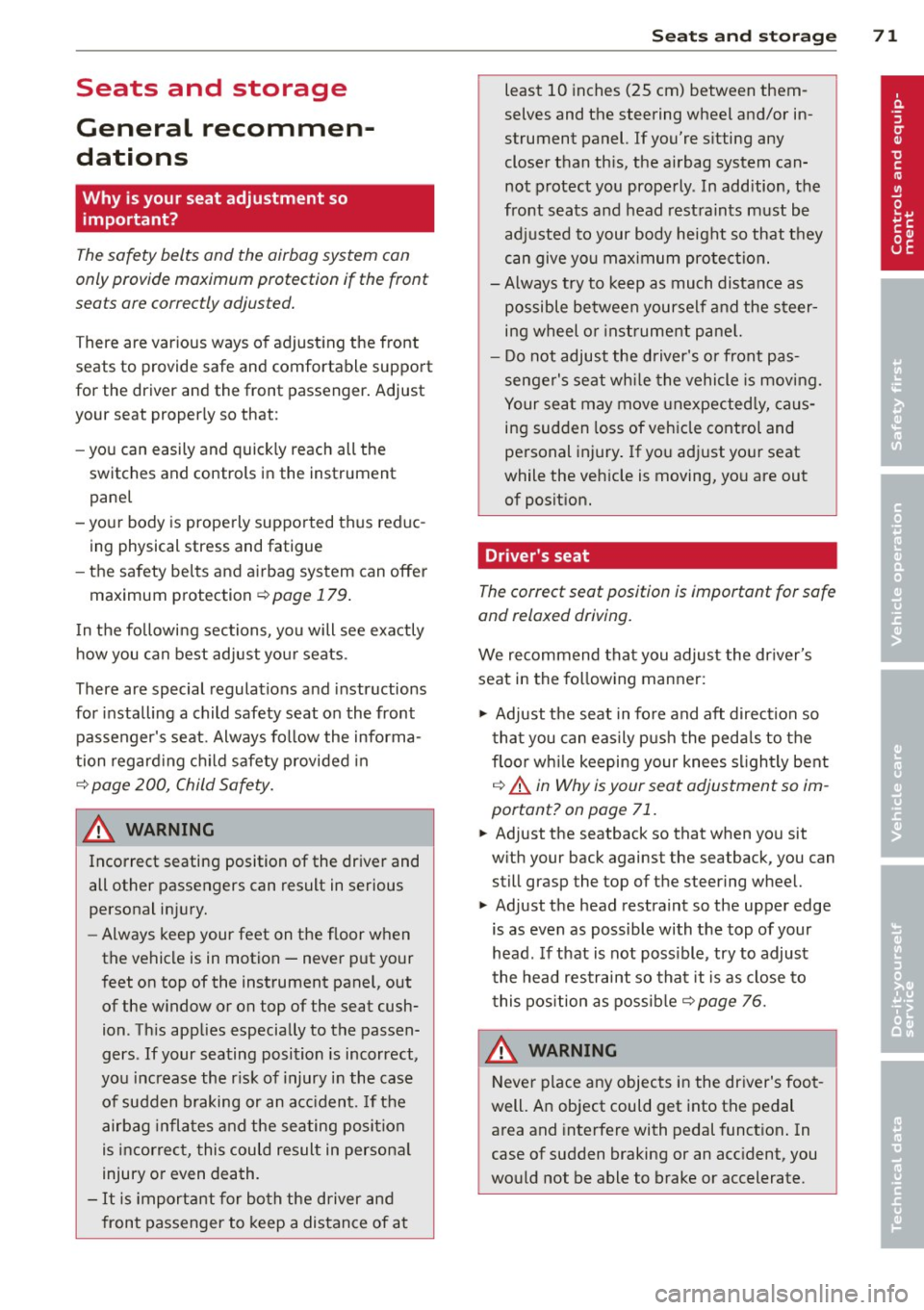
Seats and storage
General recommen
dations
Why is your seat adjustment so important?
The safety belts and the airbag system can
only provide maximum protection if the front
seats are correctly adjusted.
There are various ways of adjusting the front
seats to provide safe and comfortable support
for the driver and the front passenger. Adjust
your seat properly so that :
- you can easily and quick ly reach all the
switches and controls in the instrument
panel
- your body is properly supported thus reduc ing physical stress and fatigue
- the safety belts and airbag system can offe r
maximum protection
¢ page 179.
In the following sections, you will see exactly
how you can best adjust your seats .
There are special regulations and instructions
for installing a child safety seat on the front passenger's seat. Always follow the informa
tion regard ing child safety provided in
¢ page 200, Child Safety.
A WARNING
Incorrect seating position of the driver and
all other passengers can result in serious
personal injury.
- Always keep your feet on the f loor when
the vehicle is in motion -never p ut your
feet on top of the instrument panel, out
of the w indow or on top of the seat cush
ion. Th is applies especially to the passen
gers . If your seating position is incorrect,
you increase the r isk of injury in the case
of sudden braking or an acc ident. If the
airbag inflates and the seating position
is incorrect, this could result in persona l
injury or even death.
- It is important for bo th the driver and
front passenger to keep a distance of a t
Seat s an d sto rage 71
least 10 inches (25 cm) between them
selves and the steering wheel and/or in
strument panel. If you're s itting any
closer than th is, the airbag system can
not protect you properly. In addition, the
front seats and head restraints must be
adjusted to your body height so that t hey
can give you maximum protect ion.
- Always try to keep as much distance as
possible between yourself and the s teer
ing wheel o r instrument pane l.
- Do not adjust the driver's or front pas
senger's seat whi le the vehicle is moving.
Your sea t may move unexpected ly, caus
ing sudden loss of vehicle cont rol and
personal injury . If you adjust yo ur seat
while the veh icle is moving, yo u are out
of posit ion.
Driver's seat
The correct seat position is important for safe
and relaxed driving.
We recommend that you adjus t the dr iver's
seat in the fo llowing manner:
.,. Adjust t he seat in fore and aft direction so
that you can easily push the peda ls to the
floor wh ile keeping your knees s lightly bent
i:::> A in Why is your seat adjustment so im
portant? on page 71.
.,. Adjust the seatback so that when you sit
w ith your back against the seatback, you can
still grasp the top of the steering wheel.
.,. Adjust the head restraint so the upper edge
is as even as possible with the top of your head . If that is not poss ible , try to adjust
the head res traint so that it is as close to
this pos ition as possib le
i:::> page 76.
A WARNING
Never place any objects in the dr iver's foot
well. An object could get into the pedal
area and interfere with pedal funct ion . In
case of sudden braking or an acc ident, you
wo uld not be able to brake or accelerate.
Page 74 of 342
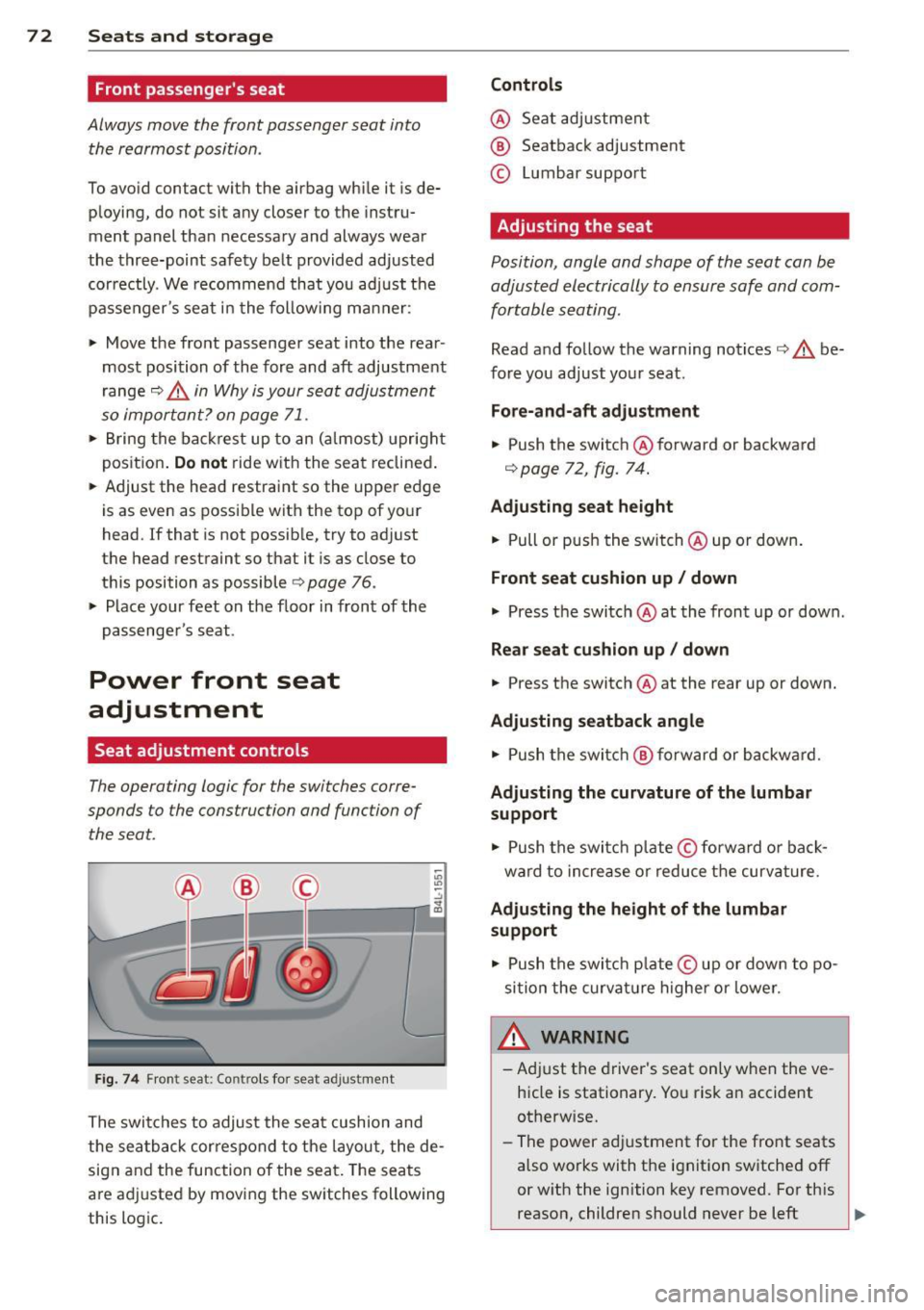
7 2 Seats and storage
Front passenger's seat
Always move the front passenger seat into
the rearmost position .
To avoid contact with the airbag while it is de
ploying, do not sit any closer to the instru
ment panel than necessa ry and always wear
the three-point safety belt provided adjusted correctly . We recommend that you adjust the
passenger's seat i n the fol low ing ma nner:
• Move the front passenger seat into the rea r
most position of the fore and aft adjustment
r ange
¢ A in Why is your seat adjustment
so important? on page 71.
• Bring the backrest up to an ( almost) uprigh t
pos it ion .
Do not ride w it h the seat reclined .
• Adjust the head restraint so the upper edge
is as even as possible with the top of your
head . If that is not possible, try to adjust
the head restraint so that it is as close to
t h is position as possible
c:> page 76 .
• Place your feet on the floor in front of the
passenger's seat .
Power front seat
adjustment
Seat adjustment controls
The operating logic for the switches corre
sponds to the construction and function of
the seat.
"' "' ~ ..,
,.._..---, 1,--~--,4 ;g
F ig . 74 Fron t seat : Co ntr ols for seat a djustment
The swi tches to adjust the sea t cushion and
the sea tback cor respond to the layou t, the de
sig n and the function of the seat. The seats
a re ad justed by movi ng the sw itches following
this logic .
Controls
@ Seat adjustmen t
® Seatback adjustment
© Lumbar suppo rt
Adjusting the seat
Position, angle and shape of the seat can be
adjusted electrically to ensure safe and
com
fortable seating .
Read and follow the warning notices c:> A be
fore you adjust yo ur seat.
Fore-and-aft adjustment
• Push the switch @forward or backward
c:> page 72 , fig. 74.
Adjusting seat height
• Pull or p ush the switch @up o r down .
Front seat cushion up/ down
• Press t he switch @at the front up or down .
Rear seat cu shion up / down
• Press the switch @at the rear up or down.
Adjusting seatback angle
• Push the switc h @ forward or backwa rd.
Ad justing the curvature of the lumbar
support
• Push the switc h plate © forward or bac k
ward to increase o r reduce t he curvature.
Adjusting the height of the lumbar
support
• Push the switc h plate © up or down to po
si tion the curva ture higher or lower.
WARNING
-Ad just the driver's seat only when the ve
h icle is stationary. Yo u risk an accident
otherwise.
- The power a djustment for the front seats
also works with the ignit ion sw itched off
or w ith the ignition key removed. For th is
reason, children should never be left ..,.
Page 79 of 342
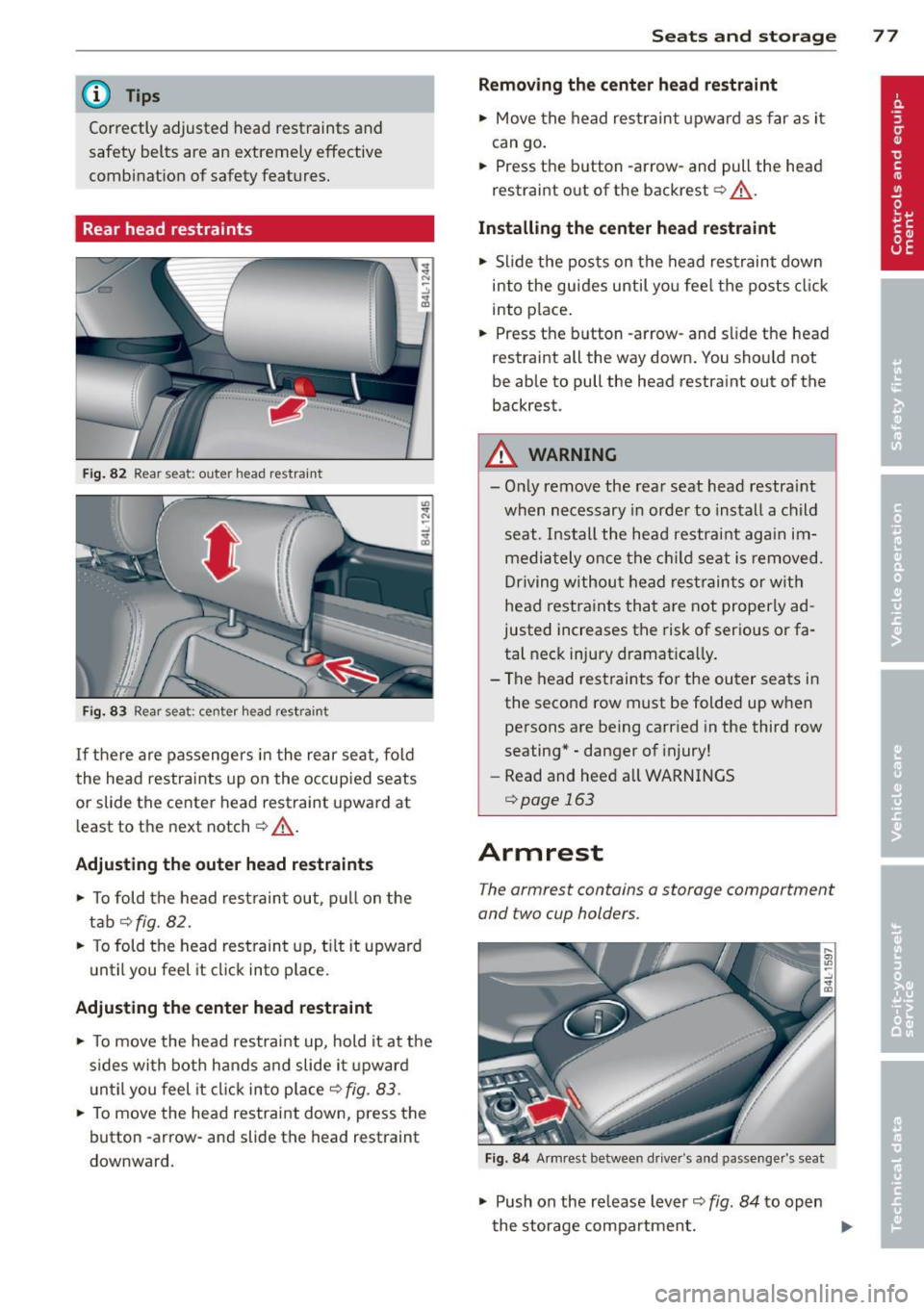
@ Tips
Correctly adjusted head restraints and
safety belts are an extremely effective
com bi nation of safety features.
Rear head restraints
F ig . 82 Rear seat: outer head restraint
Fig. 83 Rear seat; ce nte r head restraint
If there are passengers in the rear seat, fold
the head restraints up on the occupied seats
or slide the ce nter head restraint upward at
least to the next notch ¢ &, .
Adjusting the outer head restraints
• To fold the head restraint out, pull on the
tab
¢fig. 82.
• To fold the head restraint up, til t it upward
until you feel it click into place.
Adjusting the center head restraint
• To move the head restrai nt up, hold it at the
s ides with both hands and slide it upward
u ntil you feel it click into p lace
~ fig. 83.
• To move the head restraint down, press the
button -arrow- and slide the head restraint
downward.
Seats and storage 77
Removing the center head restraint
• Move the head restraint upward as far as it
can go.
• Press the b utton -arrow- and pull the head
restraint out of the backrest¢&,.
Installing the center head restraint
• Slide the posts on the head restraint down
into the guides until you fee l the posts click
into place.
• Press the button -arrow- and sl ide the head
restraint all the way down . You should not
be able to pull the head restraint out of the
backrest.
A WARNING
- Only remove the rear seat head restraint when necessary in order to install a child
seat. Install the head restraint again im mediately once the child seat is removed .
Driving without head restraints or with
head restraints that are not properly ad
justed increases the risk of serious or fa
tal neck injury dramatica lly .
- The head restraints for the outer seats in
the second row must be folded up when
persons are being carried in the third row
seating* -danger of injury!
- Read and heed all WARNINGS
¢page 163
Armrest
The armrest contains a storage compartment
and two cup holders.
Fig. 84 Armrest betwee n dri ver's and passe nger's seat
• Push on the release lever ¢ fig. 84 to open
the storage compartment.
Page 162 of 342
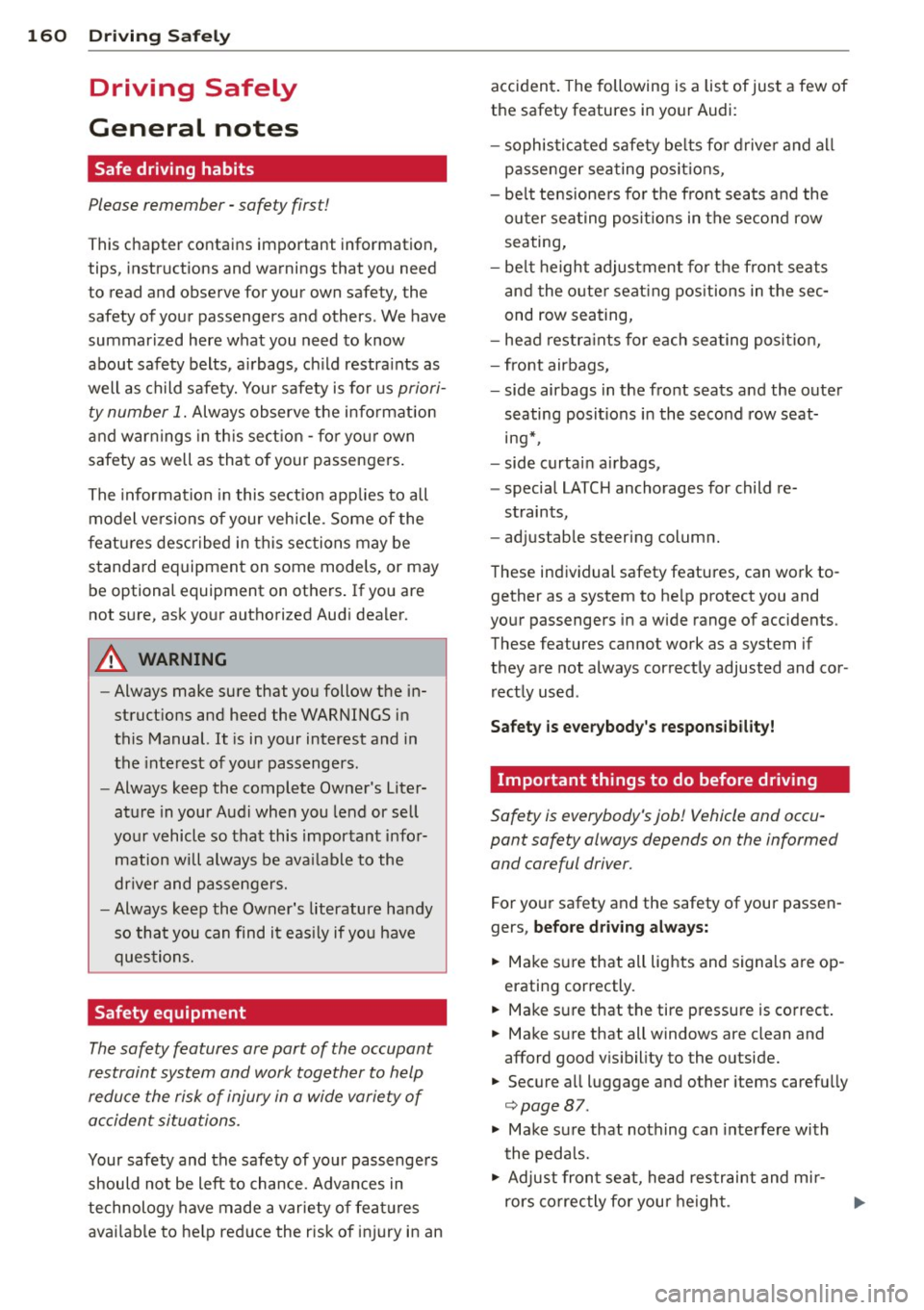
160 Driving Safel y
Driving Safely
General notes
Safe driving habits
Please remember -safety first!
This chapter contains important information,
tips, instructions and warnings that you need
to read and observe for your own safety, the
safety of your passengers and others . We have
summarized here what you need to know
about safety belts, a irbags, ch ild restra ints as
well as child safety. Your safety is for us
priori
ty number 1.
Always observe the info rmat ion
and warn ings in th is sect ion -fo r yo ur own
safety as well as that of your passengers .
The information in this se ction app lies to all
model ve rsions of your veh icle . Some of the
feat ures desc ribed in this sec tions may be
standard equipment on some models, or may be optional equipment on others . If you are
not sure, ask your authorized Aud i dealer.
A WARNING
- Always make sure that you follow the in
struct ions and heed the WARNINGS in
this Manual. It is in your interest and in
the inte rest of you r passengers.
- Always keep the complete Owner's Liter
ature in your Audi when you lend or sell
yo ur vehicle so that this important info r
mation will always be ava ilable to the
dr iver and passengers.
- Always keep the Owner's literature handy
so that you can find i t eas ily if you have
ques tions.
Safety equipment
The safety features are part of the occupant
restraint system and work together to help
redu ce the risk of injury in a wide variety of
accident situations.
Your safety and the safety of your passenge rs
should not be left to chance. Advances in
technology have made a varie ty o f fea tures
avai la bl e to he lp re duce the risk of inj ury in an accident
. The following is a list of just a few of
the safety features in your Audi:
- sophis tic ated s afety be lts for d rive r and a ll
passenger sea ting pos it ions,
- be lt te nsione rs fo r th e fro nt sea ts a nd the
ou ter sea ting posit ions in the second row
seating,
- be lt h eight adjustment fo r th e front sea ts
an d the o ute r seat ing pos itions in the sec
ond row seating,
- he ad restra ints for e ach sea ting pos ition,
- front airbags,
- side airbags in the fro nt seats and the outer
seating positions in the second row seat ing*,
- side curta in ai rbags,
- specia l LATCH anchorages for child re-
st raints,
- ad justab le steering colum n.
These individual safety features, can work to gether as a system to he lp protect you and
your passengers in a wide range of accidents .
These features cannot work as a system if
they are not always correctly adjusted and cor rectly used .
Safety is everybody's responsibil ity!
Important things to do before driving
Safety is everybody 's job! Vehicle and occu
pant safety always depends on the informed
and careful driver.
For yo ur safety and the safety of your passen
gers,
before driving always:
.. Make s ure that all lights and signa ls a re op
erati ng correctly .
.. Ma ke s ure that the tire pressure is correct .
.. Make s ure that all windows are clean and
afford good v is ibility to the o utside.
.. Secure a ll luggage a nd other items carefu lly
¢ page 87.
.. Make su re that nothing can in terfe re with
the peda ls.
.. Adjust fron t se at, head restraint and mir
rors co rrec tly for you r heigh t.
Page 163 of 342
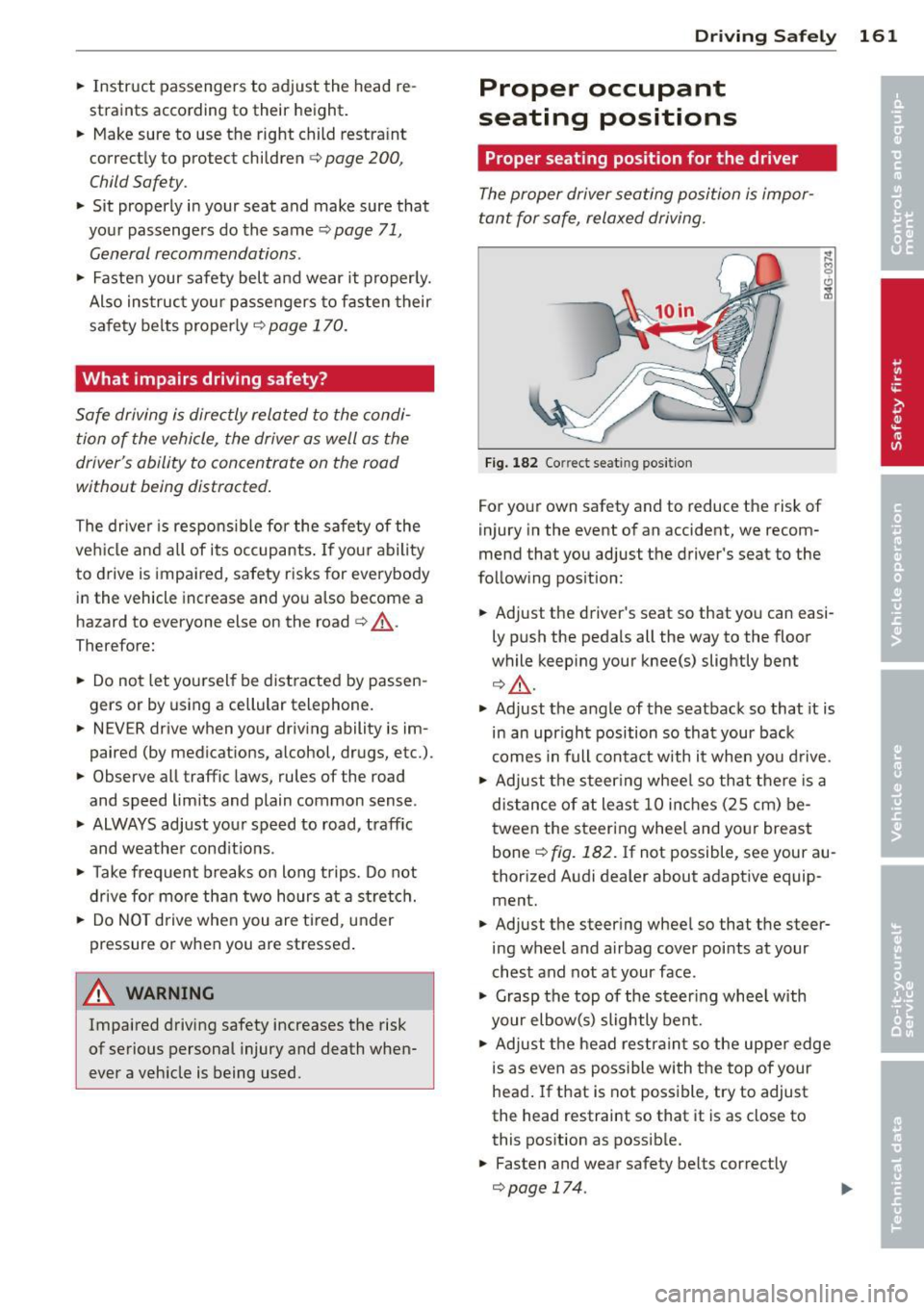
.. Instruct passengers to adjust the head re
straints according to their height.
.. Make sure to use the right child restraint
correctly to protect children
c:> page 200,
Child Safety .
.. Sit properly in your seat and make sure that
your passenge rs do the same
c:> page 71,
General recommendations .
.,. Fasten your safety belt and wear it properly.
Also ins truc t your passengers to fasten their
safety belts properly
c:> page 170.
What impairs driving safety?
Safe driving is directly related to the condi
tion of the vehicle, the driver as well as the
driver's ability to concentrate on the road
without being distracted.
The driver is respons ible for the safety of the
vehicle and a ll of its occupants . If your ability
to drive is impaired, safety risks for everybody
in the vehicle increase and you also become a
hazard to everyone else on the road
c:> .&,. .
Therefore:
.. Do not let yoursel f be distracted by passen
gers or by using a cellular telephone .
.. NEVER drive when your driving ability is im
paired (by medications, alcohol, drugs, etc.).
.. Observe all traffic laws, rules of the road
and speed limits and plain common sense .
.,. ALWAYS adjust your speed to road, traffic
and weather cond it ions .
.. Take frequent breaks on long trips. Do not
drive for more than two hours at a stretch.
.. Do NOT drive when you are tired, under
pressure or when you are stressed .
A WARNING
Impaired driving safety increases the risk
of serious personal injury and death when
ever a veh icle is being used.
Driving Safely 161
Proper occupant
seating positions
Proper seating position for the driver
The proper driver seating position is impor
tant for safe, relaxed driving.
Fig. 182 Correct seat ing pos it ion
For your own safety and to reduce the risk of
injury in the event of an accident, we recom
mend that you adjust the driver's seat to the
follow ing position:
.. Adjust the driver's seat so that you can easi
ly push the pedals all the way to the floor
wh ile keeping your knee(s) slightly bent
c:> .&,. .
.. Adjust the angle of the seatback so that it is
in an upr ight position so that your back
comes in full contact w ith it when you drive .
.. Adjust the steering wheel so that there is a
distance of at least 10 inches (25 cm) be
tween the steering wheel and yo ur breast
bone ~
fig. 182. If not possible, see your au
thorized Audi dealer about adaptive equip
ment .
.. Adjust the steer ing wheel so that the steer
ing wheel and airbag cover points at your
chest and not at your face.
.,. Grasp the top of the steer ing whee l with
your elbow(s) slightly bent.
.. Adjust the head restraint so the upper edge
is as even as possible with the top of your
head. If that is not poss ible, try to adjust
the head restraint so that it is as close to
this position as possible .
.. Fasten and wear safety belts correctly
c:>page 174.
Page 164 of 342
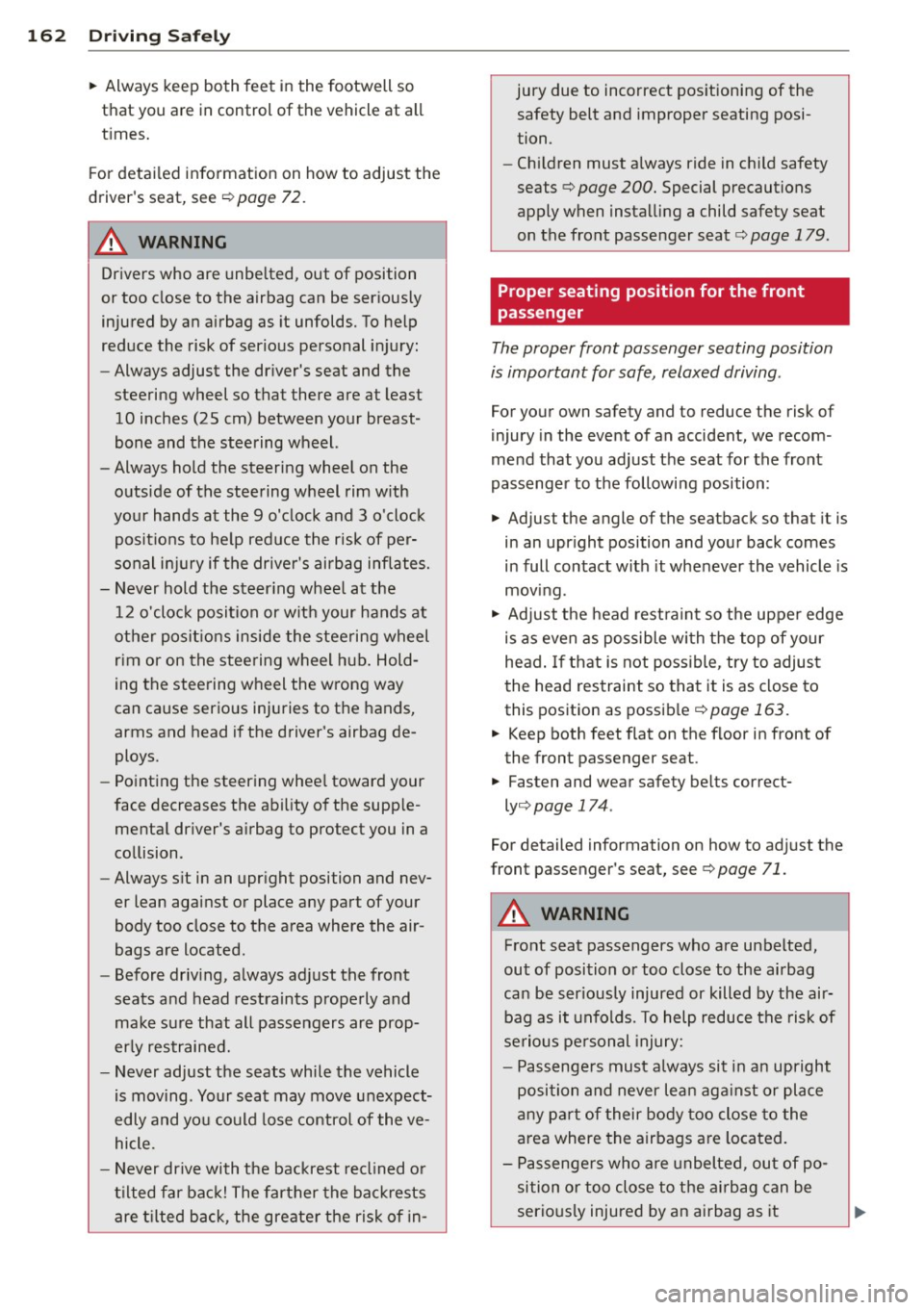
162 Driving Safely
• Always keep both feet in the footwell so
that you are in control of the vehicle at all
times.
For detailed information on how to adjust the
driver's seat, see
¢ page 72.
A WARNING
Drivers who are unbelted, out of position
or too close to the airbag can be seriously
injured by an airbag as it unfolds. To help
reduce the risk of serious personal injury:
- Always adjust the driver's seat and the
steering wheel so that there are at least
10 inches (25 cm) between your breast
bone and the steering wheel.
- Always hold the steering wheel on the
outside of the steering wheel rim with
your hands at the 9 o'clock and 3 o'clock positions to help reduce the risk of per
sonal injury if the driver's airbag inflates.
- Never hold the steering wheel at the
12 o'clock position or with your hands at
other positions inside the steering wheel
rim or on the steering wheel hub. Hold
ing the steering wheel the wrong way
can cause serious injuries to the hands,
arms and head if the driver's airbag de
ploys.
- Pointing the steering wheel toward your
face decreases the ability of the supple
mental driver 's airbag to protect you in a
collision .
- Always sit in an upright position and nev
er lean against or place any part of your
body too close to the area where the air
bags are located.
- Before driving, always adjust the front
seats and head restraints properly and
make sure that all passengers are prop
erly restrained.
- Never adjust the seats while the vehicle
is moving . Your seat may move unexpect
edly and you could lose control of the ve
hicle.
- Never drive with the backrest reclined or
tilted far back! The farther the backrests
are tilted back, the greater the risk of in- jury due to incorrect positioning of the
safety belt and improper seating posi
tion.
- Children must always ride in child safety
seats ¢
page 200. Special precautions
apply when installing a child safety seat
on the front passenger seat¢
page 179 .
Proper seating position for the front
passenger
The proper front passenger seating position
is important for safe, relaxed driving .
For your own safety and to reduce the risk of
injury in the event of an accident, we recom
mend that you adjust the seat for the front
passenger to the following position :
• Adjust the angle of the seatback so that it is
in an upright position and your back comes
in full contact with it whenever the vehicle is
moving .
• Adjust the head restraint so the upper edge
is as even as possible with the top of your
head. If that is not possible, try to adjust
the head restraint so that it is as close to
this position as possible ¢
page 163.
• Keep both feet flat on the floor in front of
the front passenger seat .
• Fasten and wear safety belts correct
ly ¢
page 174 .
For detailed information on how to adjust the
front passenger's seat, see ¢
page 71.
A WARNING
-Front seat passengers who are unbelted,
out of position or too close to the airbag
can be seriously injured or killed by the air
bag as it unfolds. To help reduce the risk of
serious personal injury:
- Passengers must always sit in an upright
position and never lean against or place
any part of their body too close to the
area where the airbags are located.
- Passengers who are unbelted, out of po
sition or too close to the airbag can be
seriously injured by an airbag as it
Page 165 of 342

unfolds with great force in the blink of
an eye .
- Always make sure that there are at least
10 inches (25 cm) between the front
passenger 's breastbone and the instru
ment panel.
- Each passenger must always sit on a seat of the ir own and properly fasten and
wear the safety belt be longing to that
seat .
- Before driving, always adjust the front
passenger seat and head restra int prop
erly .
- Always keep your feet on the f loor in
front of the seat. Never rest them on the
seat, instrument panel, out of the win dow, etc. The airbag system and safety
belt w il l not be ab le to protec t you prop
er ly and can even increase the risk of in
jury in a crash .
- Never drive with the backrest reclined o r
ti lted far back! The farther the backrests
are ti lted back , the greater the risk of in
jury due to incorrect positioning of the
safety belt and improper seating posi
t ion.
- Children must always ride in child safety
seats
c> page 200 . Special precautions
apply when installing a child safety seat
on the front passenger seat
c> page 179 .
Proper seating positions for passengers
in rear seats
Rear seat passengers must sit upright with
both feet on the floor consistent with their
physical size and be properly restrained whenever the vehicle is in use .
To reduce the risk of injury caused by an incor
rect seat ing pos ition in the event of a sudden
brak ing maneuve r or an acc ident , your pas
se ngers on the rea r bench seat must always
observe the fo llow ing :
~ If there are passengers in the rear seat, fold
the head rest ra ints up on the occupied seats
or slide the center head restrain t upward at
least to the next notch
c> page 77 .
Dr ivin g Sa fely 163
~ Make s ure that the seatback is secure ly
latch ed in the upright posi tion
c> page 79.
~ Keep both feet flat in the footwell in front
of the rear seat.
~ F asten and wear safety be lt s properly
<=> page 174 .
~ Make sure that children are always properly
restrained in a child restraint that is appro
pria te fo r the ir s ize and age ¢
page 200.
A WARNING
Passengers who are imp roperly seated on
the rear seat can be se riously inj ured in a
crash .
- Each passenger must always si t on a seat
of their own and properly fasten and
wear the safety belt belonging to that
seat .
- Safety belts only offer maximum protec
tion when the seatback is sec urely latch
ed in the upright position and the safety
be lt s are properly posit ioned on the
body . By not s itting up right, a rear seat
passenger increases the risk of personal
in jury from improperly positioned safety
be lts!
- Always adjust the head restraint p roperly
so that it can give maximum protection .
Proper adjustment of head restraints
Correctly adjusted head restraints are an im
portant port of your vehicle's occupant re
straint system and can help to reduce the risk
of injuries in accident situations .
Fig. 1 83 Head restr ain t: v ie wed from th e front
The head restraints must be correct ly adjust-
ed to achieve the best protectio n. ..,.
Page 166 of 342
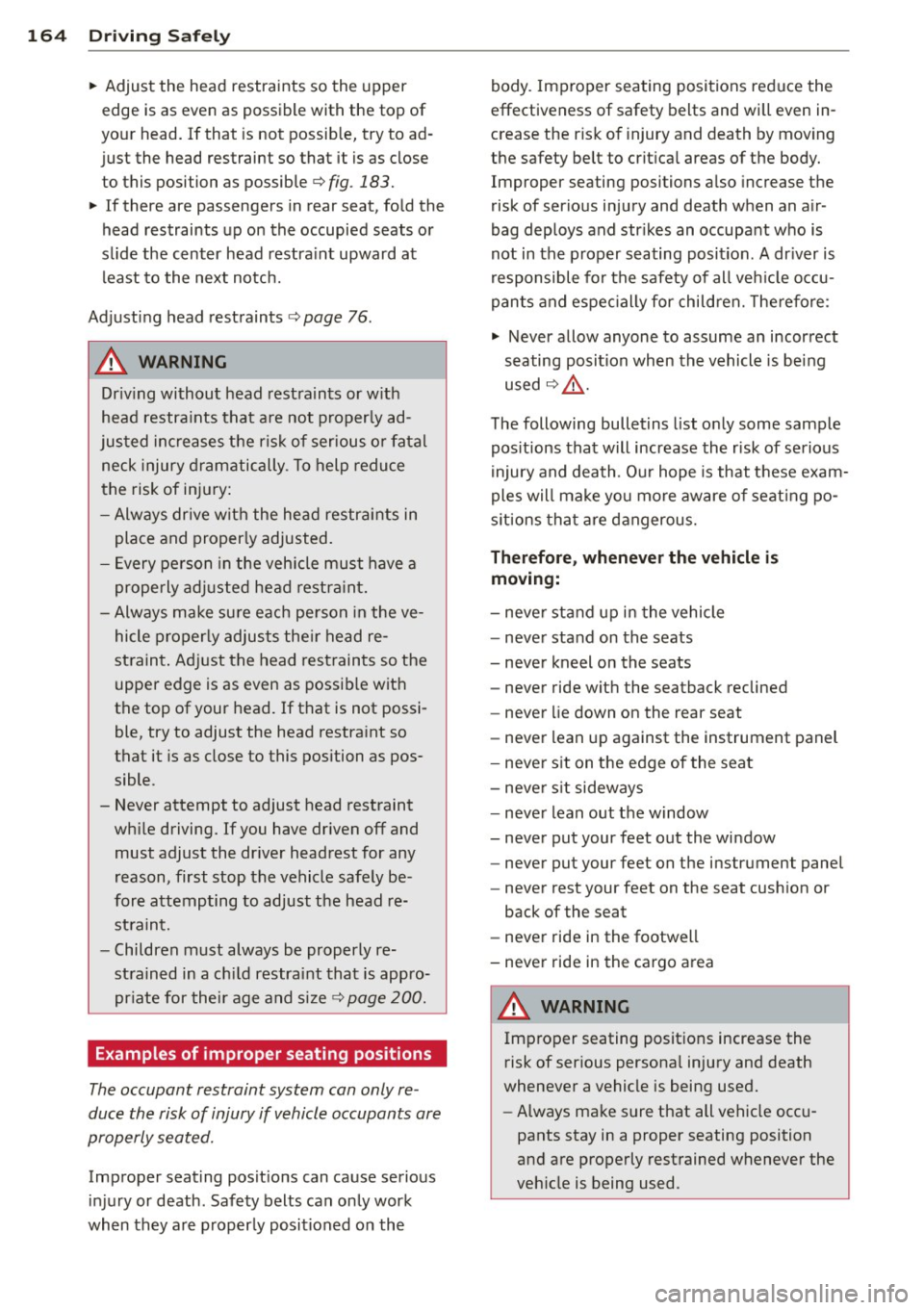
164 Driving Safel y
• Adjust the head restraints so the upper
edge is as even as possible with the top of
your head. If that is not possib le, try to ad
just the head restraint so that it is as close
to this position as possible
q fig. 183.
• If there are passengers in rear seat, fold the
head restraints up on the occupied seats or
s lide the center head restra int upward at
least to the next notch.
Adjusting head restraints
q page 76 .
A WARNING
-
Driv ing without head restraints or w ith
head restra ints that are not properly ad
justed increases the risk of serious o r fatal
neck injury dramatically. To help reduce
t he risk of injury:
- Always drive with the head restraints in
place and properly adjusted.
- E very pe rson in the veh icle must have a
properly ad justed head restra int.
- Always make su re each pe rson in the ve
hicle properly adjusts the ir head re
straint. Ad just the head restraints so the
upper edge is as even as possib le with
the top of your head. If that is not possi
ble, try to adjust the head restraint so
that it is as close to this position as pos
sible.
- Never attempt to adjust head restraint
wh ile driving. If you have driven
off and
must adjust the driver headrest for any
reason, first stop the vehicle safe ly be
fore attempting to adjust the head re
st rain t.
- Children must always be properly re
strained in a ch ild restraint that is appro
pr iate for their age a nd s ize
q page 200.
Examples of improper seating positions
The occupant restraint system can only re
duce the risk of injury if vehicle occupants are
properly seated.
Improper seating positions can cause serious
injury or death. Safety belts can only work
when they a re p roperly positioned on the body. Improper seating positions reduce the
effectiveness
of safety belts and will even in
c rease the risk o f injury and death by moving
the safety belt to crit ica l areas of the body.
Improper seating positions also increase the
risk of serious injury and death when an air
bag deploys and str ikes an occupant w ho is
not in the proper s eating position. A dr iver is
responsible for the safety of all veh icle o ccu
pants and espec ially for child ren. The re fo re:
• Never allow anyone to assume an incorrect
seating position when the vehicle is being
used
Q & .
The following bulletins list o nly some sample
pos itions tha t w ill increase the r isk of serious
i njury and dea th. O ur hope is that t hese exam
ples will ma ke yo u more aware o f seat ing po
s itions tha t a re dangerous.
Th erefore , whenever the vehicle is
moving:
- neve r sta nd up i n the vehicle
- neve r stand on the seats
- never kneel on the seats
- never ride wit h the seatback reclined
- never lie down on the rear seat
- never lean up against the instrument panel
- neve r sit on the e dge of the seat
- neve r sit sideways
- neve r lean out the window
- never put your feet out the window
- never put your feet on the instrument panel
- never rest your feet on the seat cushion or
back of the seat
- neve r ride in the footwell
- never ride in the cargo a rea
A WARNING
Imp roper seating positions increase the
risk of ser ious persona l injury and death
whenever a vehicle is being used.
- Always make sure that all vehicle occ u-
pants stay in a proper seating position
and are properly restrained whenever the
veh icle is being used.
Page 175 of 342
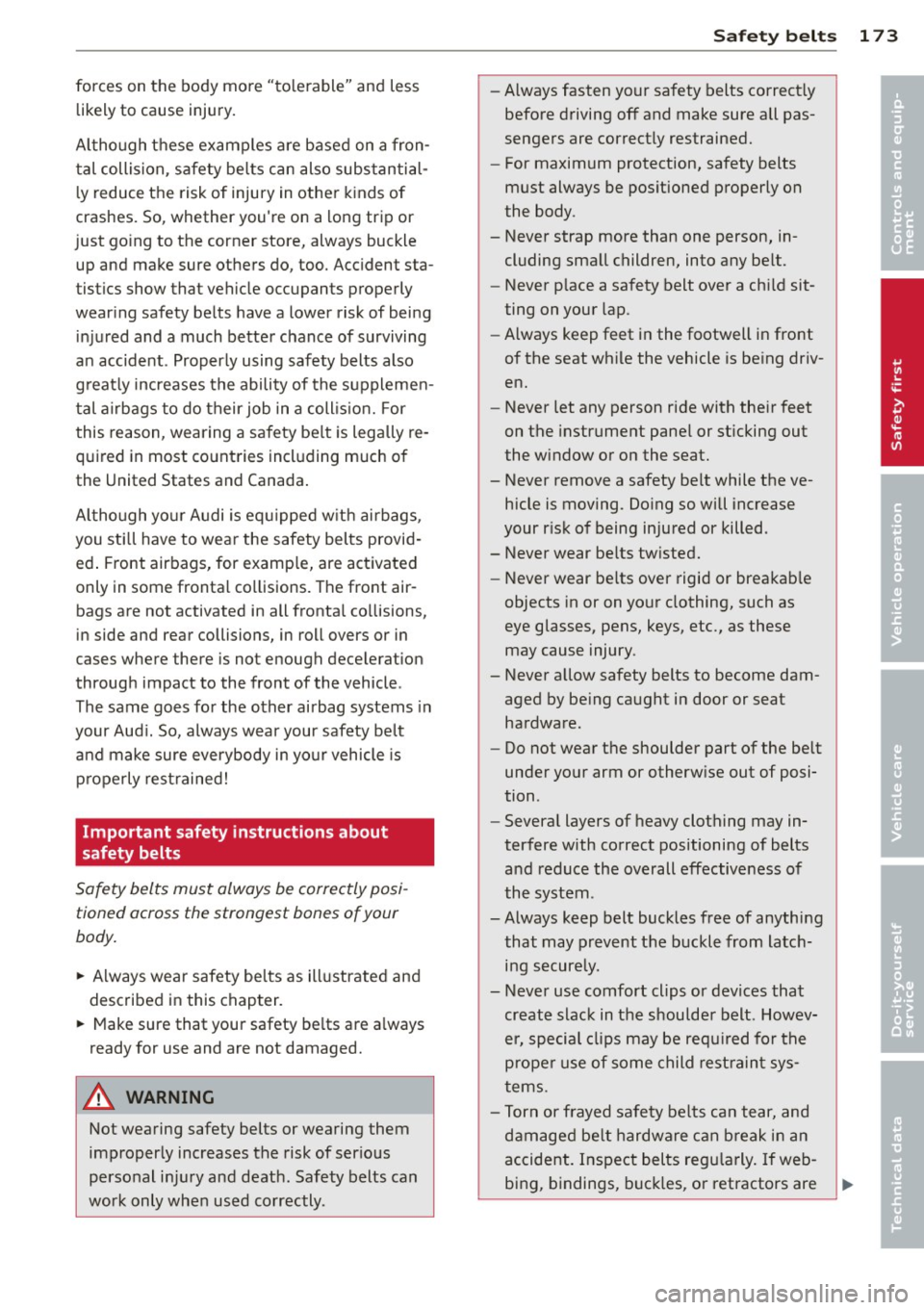
forces on the body more "tolerable" and less likely to cause injury.
Although these examples are based on a fron
tal collision , safety belts can also substantial
ly reduce the risk of injury in other kinds of
crashes. So, whether you're on a long trip or
just going to the corner store, always buckle
up and make sure others do, too. Accident sta
tistics show that vehicle occupants properly
wearing safety belts have a lower risk of being
injured and a much better chance of surviving
an accident . Properly using safety belts also
greatly increases the ability of the supplemen
tal airbags to do their job in a collision. For
this reason, wearing a safety belt is legally re
quired in most countries including much of
the United States and Canada.
Although your Audi is equipped with airbags ,
you still have to wear the safety belts provid
ed. Front airbags, for example, are activated
only in some frontal collisions. The front air
bags are not activated in all frontal collisions,
in side and rear collisions, in roll overs or in
cases where there is not enough deceleration
through impact to the front of the vehicle .
The same goes for the other airbag systems in
your Audi. So, always wear your safety belt
and make sure everybody in your vehicle is
properly restrained!
Important safety instructions about
safety belts
Safety belts must always be correctly posi
tioned across the strongest bones of your
body.
.,. Always wear safety belts as illustrated and
described in this chapter.
.,. Make sure that your safety belts are always
ready for use and are not damaged.
A WARNING
Not wearing safety belts or wearing them
improperly increases the risk of serious
personal injury and death. Safety belts can
work only when used correctly .
Safety belts 173
-Always fasten your safety belts correctly
before driving off and make sure all pas
sengers are correctly restrained.
- For maximum protection, safety belts
must always be positioned properly on
the body .
- Never strap more than one person, in cluding small children, into any belt .
- Never place a safety belt over a child sit
ting on your lap.
- Always keep feet in the footwell in front
of the seat while the vehicle is being driv
en.
- Never let any person ride with their feet
on the instrument panel or sticking out
the window or on the seat.
- Never remove a safety belt while the ve hicle is moving. Doing so will increase
your risk of being injured or killed .
- Never wear belts twisted.
- Never wear belts over rigid or breakable
objects in or on your clothing, such as
eye glasses, pens, keys, etc., as these
may cause injury.
- Never allow safety belts to become dam aged by being caught in door or seat
hardware .
- Do not wear the shoulder part of the belt
under your arm or otherwise out of posi
tion .
- Several layers of heavy clothing may in
terfere with correct positioning of belts
and reduce the overall effectiveness of
the system .
- Always keep belt buckles free of anything
that may prevent the buckle from latch
ing securely .
- Never use comfort clips or devices that
create slack in the shoulder belt. Howev
er, special clips may be required for the
proper use of some child restraint sys
tems .
- Torn or frayed safety belts can tear, and
damaged belt hardware can break in an
accident. Inspect belts regularly. If web-
bing, bindings, buckles, or retractors are .,..
L,_ _______________ _J
•
•
Page 177 of 342

the wrong buckle will reduce safety belt
effectiveness and can cause serious per
sonal injury.
- A passenger who is not properly restrain
ed can be seriously injured by the safety
belt itself when it moves from the stron
ger parts of the body into critical areas
like the abdomen .
- Always lock the convertible locking re
tractor when you are secur ing a child
safety seat in the vehicle
~ page 211 .
Safety belt position
Correct bel t posi tion is the key to getting
maximum protection from safety belts .
Fig. 192 Safety be lt pos it io n
Standard features on your vehicle help you ad
just the position of the safety belt to match
your body size.
- belt height adjustment for the front seats
and the outer seating positions in the sec
ond row seating,
- height-adjustable front seats.
A WARNING
Improperly positioned safety belts can
cause serious personal injury in an acci
dent.
-
- The shoulder belt should lie as close to
the center of the collar bone as possible
and should fit well on the body. Hold the
belt above the latch tongue and pull it
evenly across the chest so that it sits as
low as possible on the pelvis and there is
no pressure on the abdomen . The belt
Safety belts 175
should always fit snugly¢ fig. 192. Pull
on the belt to tighten if necessary.
- The lap belt portion of the safety belt
must be positioned as low as possible
across pelvis and never over the abdo
men . Make sure the belt lies flat and
snug ¢
fig. 192 . Pull on the belt to tight
en if necessary .
- A loose-fitting safety belt can cause seri
ous injuries by shifting its pos ition on
your body from the strong bones to more
vulnerable, soft tissue and cause serious
injury.
- Always read and heed all WARNINGS and
other important information
¢ page 173.
Pregnant women must also be correctly
restrained
The best way to protect the fetus is to make
sure that expectant mothers always wear
safety belts correctly -throughout the preg
nancy.
Fig. 193 Safety belt pos ition du ring pregnan cy
To provide max imum protection, safety belts
must always be positioned correctly on the
wearer's body¢
page 175 .
.,. Adjust the front seat and head restraint cor
rectly ¢
page 71 , General recommenda
tions .
.,. Make sure the seatback of the rear seat
bench is in an upright position and securely
latched in place before using the belt.
... Hold the belt by the tongue and pull it
evenly across the chest and pelvis
¢fig. 193, ¢ A.